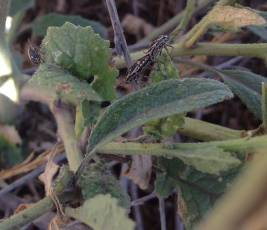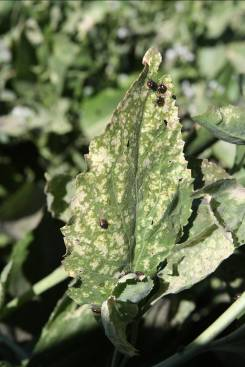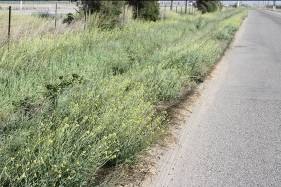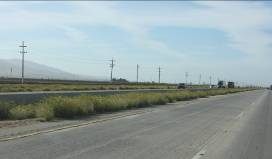
Bagrada bug was first observed in fields of spring mix and broccoli in the south end of the valley between King City and San Ardo. Upon inspection of the weeds in the areas surrounding these fields, bagrada bug was observed on shortpod mustard (Hirschfeldia incana–photo 1) and perennial pepperweed (Lepidium latifolium–photo 2). Shortpod mustard is common along roadsides, dry ditches, in rangeland and other untilled areas near fields. Perennial pepperweed occurs in the riparian area along the Salinas River as well as along roadsides and fence lines. Both of these weeds provide green tissue during the dry summer months that allow bagrada bug to reproduce and increase its population. Another summer mustard common in the Salinas Valley is perennial wallrocket (Diplotaxis tenuifolia), but to this date, bagrada bug has not been observed on this species (photo 3).

Clearly mustards can provide habitat for bagrada bug which can then invade adjacent production fields. Once in a field of cole crops, bagrada bug begins egg laying. It lays eggs singly or in cluster which normally starts about 3-4 weeks after adult emergence. Typically, bagrada bug is found in aggregations consisting of adults and nymphs. Adults can live up to three months. Injury on leaves appears initially as small puncture marks, which turn into white patches as leaves expand. Damage is most severe when injury occurs early in the developmental of the crop (< 4 leaves stages). Damage on broccoli and cauliflower occurs from feeding on the apical meristem of young seedling, which later result in multiple or blind heads (lack of heads).
During this dry time of the year, shortpod mustard and perennial pepper weed provide habitat for this insect. During the winter, habitat for bagrada bug will presumably be available as winter-growing mustards germinate with the first rains and grown along roadsides, ditches and other non-cultivated areas (photo 4). Winter growing mustards and radish occur over in a large number of areas in the Salinas Valley; they will provide green tissue that could provide food resources for bagrada bug until early summer when the summer-growing species provide food resources for this insect, thereby providing year-round resources for this insect. In general, growers keep weeds adjacent to vegetable production fields under good control, but fields that butt up against the river or that have road right of ways next to their property may have difficulty reducing habitat for this insect. It is a good idea for growers and PCAs to keep an eye on the mustard family weeds in areas adjacent to production fields and control them to reduce the population and movement of this bug into production fields. Mustard family weeds unfortunately are providing the food resources and habitat for bagrada bug to easily move north into Monterey County.
